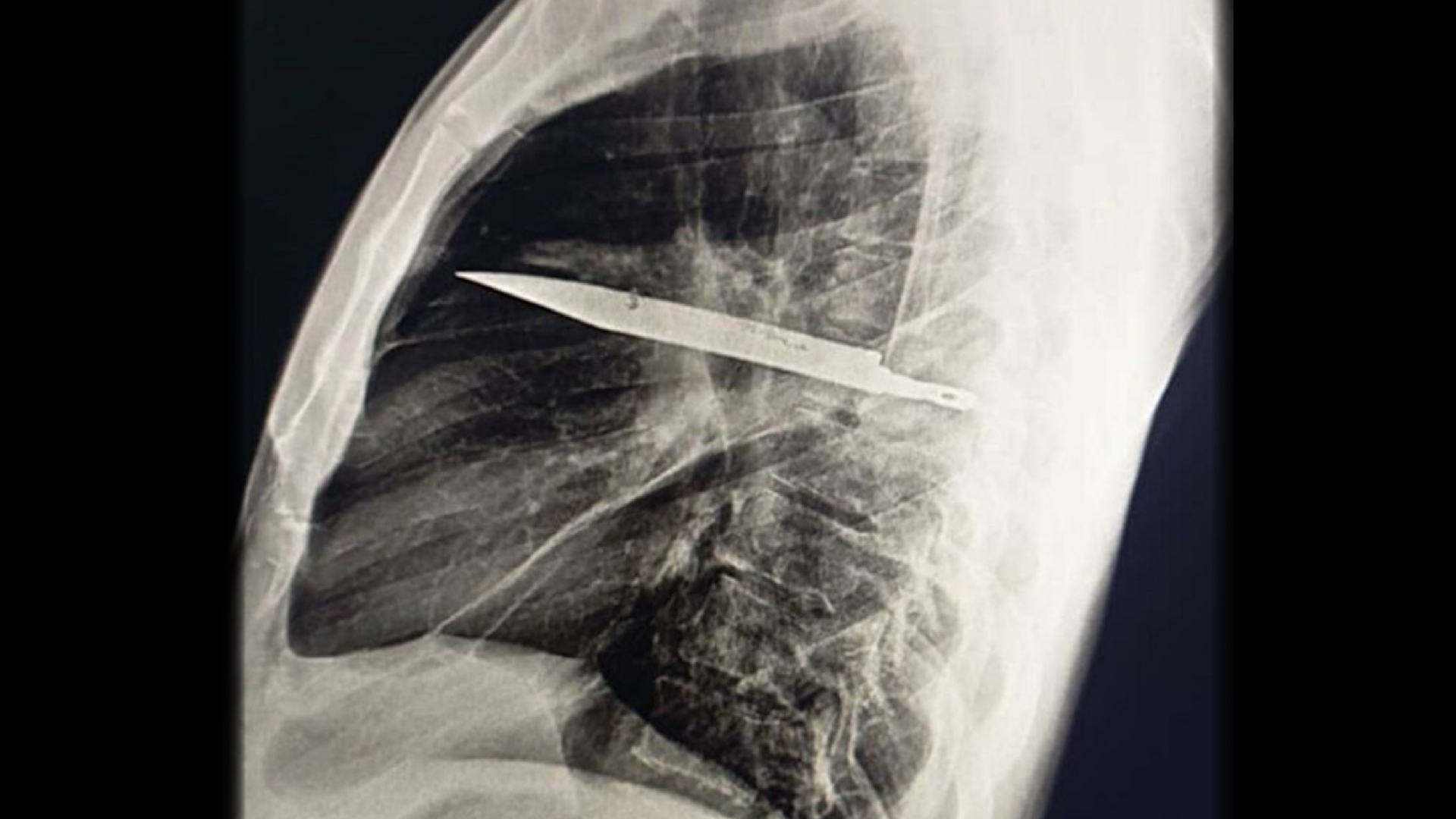By Mindy Weisberger
Copyright livescience

Skip to main content
Close main menu
Live Science
Sign up to our newsletter
View Profile
Search Live Science
Planet Earth
Archaeology
Physics & Math
Human Behavior
Science news
Life’s Little Mysteries
Science quizzes
Newsletters
Story archive
Skyscraper-sized asteroid flyby
Diagnostic dilemma
Elusive ‘grumpy’ cat photographed
Anthropologist Ella Al-Shamahi on human origins
How misinformation spreads
Don’t miss these
Weird lump in woman’s hip was sponge left behind during C-section
A man was stabbed through the throat and the base of the skull — by a fish
Shingles popped a hole in a man’s bladder
Archaeology
An exotic quartz arrow may have killed a man 12,000 years ago in Vietnam
A man’s preference for ‘soft’ bacon may have given him brain worms
Archaeology
4,000-year-old human rib discovered high in the Pyrenees still has an arrowhead from a brutal attack
A woman had something in her eye — and it turned out to be parasitic worms
Girl’s dental trouble caused a life-threatening eye infection
A woman kept tasting bleach — and doctors found a hidden cause in her blood
Hunter’s rare allergy meant he could no longer eat red meat
Viruses, Infections & Disease
Man’s body crawling with parasitic worms after infected kidney transplant at US hospital
Weird swelling of man’s fingers and toes revealed cancer had ‘completely replaced’ the bones with lesions
Archaeology
350-year-old mummified head from Bolivia isn’t what it seems
Mysterious migraines after heart surgery may finally be explained
Rare semen allergy may have caused woman’s infertility
Diagnostic dilemma: A knife broke off in a man’s chest, and he didn’t notice it for 8 years
Mindy Weisberger
17 September 2025
A man noticed pus oozing from his chest, and it ended up revealing a knife blade in his thoracic cavity.
When you purchase through links on our site, we may earn an affiliate commission. Here’s how it works.
This radiograph of the patient’s chest shows the large blade stuck in in the mid-thorax.
(Image credit: Kivuyo et al. J Surg Case Rep. 2025 May 31;2025(6):rjaf325; CC BY 4.0)
The patient: A 44-year-old man in Tanzania
The symptoms: For 10 days, pus oozed from an opening in the man’s chest below his right nipple, prompting him to visit the emergency room. He told doctors he had no pain or difficulty breathing. He did not have a fever, and his vital signs were normal.
What happened next: When the doctors examined the man, they found that his rib cage on the right side of his chest was flattened at the front and that his chest did not fully expand on that side when he inhaled. They confirmed that “foul-smelling” pus was leaking from a cavity under the nipple, they wrote in a report of the case.
You may like
Weird lump in woman’s hip was sponge left behind during C-section
A man was stabbed through the throat and the base of the skull — by a fish
Shingles popped a hole in a man’s bladder
During the examination, the man reported that, eight years earlier, he had been stabbed repeatedly in the chest, back, abdomen and face during a “violent altercation.” No imaging tests were performed at that time, and he received only superficial first-aid treatment for the multiple knife wounds. For eight years, he had no health issues resulting from those injuries, he said.
The diagnosis: An X-ray revealed a large metallic knife blade lodged inside the man’s thoracic cavity. Also known as the chest cavity, this hollow chamber is located above the abdomen and contains the heart and lungs. The blade, which extended from the rear of the rib cage to the front, had entered the man’s back near his right scapula, or shoulder blade.
The knife’s blade slid between the fifth and sixth ribs in the patient’s back and then stuck there, with the knife’s tip positioned between the third and fourth ribs at the front of his rib cage. A CT scan showed healed fractures in his scapula and in several ribs. Layers of pus and dead or dying tissue surrounded the knife blade.
One way the body protects itself against foreign objects is through a process called fibrous capsule formation, in which the immune system cocoons the object in collagen and other fibers to limit damage and inflammation in the surrounding tissue. Such encapsulation of the knife is likely what enabled the man to spend the next eight years unaware that there was a blade inside his chest, according to the report.
Sign up for the Live Science daily newsletter now
Get the world’s most fascinating discoveries delivered straight to your inbox.
Contact me with news and offers from other Future brandsReceive email from us on behalf of our trusted partners or sponsorsBy submitting your information you agree to the Terms & Conditions and Privacy Policy and are aged 16 or over.
This CT scan (left) shows the retained knife blade in the man’s chest, and the 3D reconstructed CT chest image (right) shows both the knife and the associated skeletal injuries it caused. (Image credit: Kivuyo et al. J Surg Case Rep. 2025 May 31;2025(6):rjaf325; CC BY 4.0)
The treatment: Surgeons at the hospital performed a thoracotomy, in which they cut into the man’s chest wall to remove the blade. They drained the accumulated pus, flushed the chest cavity with a solution of sodium chloride, installed a drainage tube and finally sutured the wound. The patient received broad-spectrum antibiotics for seven days and was closely monitored for signs of infection following the surgery.
Doctors removed the drainage tube after the eighth day, and the man was discharged two days later. He returned to the hospital for two follow-up appointments: one two weeks after his surgery, and one six weeks afterward. At both visits, he was infection-free and experienced no further complications.
OTHER DILEMMAS
—Woman’s severe knee pain reveals ‘golden threads’ in her joints
—A woman started eating foam from her chair while receiving dialysis
—Orgasm involving a kitchen whisk likely triggered person’s fatal aneurysm
What makes the case unique: After a traumatic chest injury, it’s not unusual for part or all of the penetrating object to be left behind in the chest cavity. However, most of the time, these foreign bodies are small ballistic projectiles, such as bullets, which are often difficult to locate and remove.
By comparison, large shards — for example, entire knife blades or other stabbing weapons — that break off and become lodged in the chest are less commonly documented in the medical literature. And in most cases, these objects do not go undetected for years; they are typically identified and removed within weeks or months, according to the report.
This article is for informational purposes only and is not meant to offer medical advice.
Diagnostic dilemma
Mindy Weisberger
Social Links Navigation
Live Science Contributor
Mindy Weisberger is a science journalist and author of “Rise of the Zombie Bugs: The Surprising Science of Parasitic Mind-Control” (Hopkins Press). She formerly edited for Scholastic and was a channel editor and senior writer for Live Science. She has reported on general science, covering climate change, paleontology, biology and space. Mindy studied film at Columbia University; prior to LS, she produced, wrote and directed media for the American Museum of Natural History in NYC. Her videos about dinosaurs, astrophysics, biodiversity and evolution appear in museums and science centers worldwide, earning awards such as the CINE Golden Eagle and the Communicator Award of Excellence. Her writing has also appeared in Scientific American, The Washington Post, How It Works Magazine and CNN.
You must confirm your public display name before commenting
Please logout and then login again, you will then be prompted to enter your display name.
Weird lump in woman’s hip was sponge left behind during C-section
A man was stabbed through the throat and the base of the skull — by a fish
Shingles popped a hole in a man’s bladder
An exotic quartz arrow may have killed a man 12,000 years ago in Vietnam
A man’s preference for ‘soft’ bacon may have given him brain worms
4,000-year-old human rib discovered high in the Pyrenees still has an arrowhead from a brutal attack
Latest in Health
A tragic gene therapy death that stalled the field for a decade — Sept. 17, 1999
‘Russian nesting doll’ virus hides inside a deadly fungus, making it even more dangerous to people
Diet change could make brain cancer easier to treat, early study hints
Have you gotten this year’s COVID vaccine?
Science news this week: NASA finds best evidence of life on Mars and scientists invent visible time crystals
‘Your fear is well-founded’: How human activities have raised the risk of tick-borne diseases like Lyme
Latest in Features
Science history: Gravitational waves detected, proving Einstein right — Sept. 14, 2015
Volcanic ‘googly eyes’ stare into space from skull-like peninsula
James Webb telescope’s ‘starlit mountaintop’ could be the observatory’s best image yet — Space photo of the week
Where is Queen Boudica buried?
Camera trap in Chile detects strange lights blazing through the wilderness. Researchers are scrambling to explain them.
Where could alien life exist in our solar system?
LATEST ARTICLES
Science history: A tragic gene therapy death that stalled the field for a decade — Sept. 17, 1999
‘We certainly weren’t exceptional, but now we’re the only ones left’: In new PBS series ‘Human,’ anthropologist Ella Al-Shamahi explores how humans came to dominate Earth
1,900-year-old ‘treasure’ found in Roman-era family’s scorched house in Romania
Skyscraper-size asteroid previously predicted to hit us in 60 years will zoom past Earth on Thursday (Sept. 18) — and you can see it live
Grumpy-looking Pallas’s cat photographed by camera trap in stunning photo from eastern Himalayas
Live Science is part of Future US Inc, an international media group and leading digital publisher. Visit our corporate site.
Contact Future’s experts
Terms and conditions
Privacy policy
Cookies policy
Accessibility Statement
Advertise with us
Web notifications
Editorial standards
How to pitch a story to us
Future US, Inc. Full 7th Floor, 130 West 42nd Street,
Please login or signup to comment
Please wait…



